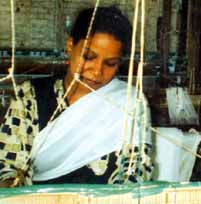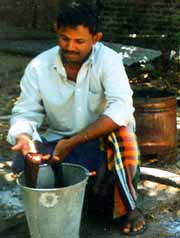 A woman at the loom |
by ASIFF HUSSEIN - Sunday Observer July 6 2003
 A woman at the loom |
The little known Moorish town of Marudamunai in the Ampara district has a tradition of weaving said to go back to Kandyan times. The Moors here, it is believed, were settled in the days of King Senarat for purposes of weaving and dyeing cloth, a tradition that continues to this day.
Although these expert Nesavalar or weavers formerly manufactured garments such as somans and sirwals which are no longer used, they now largely produce sarees and sarongs to meet the demands of today's market. Although Palamunai and Kattankudi in the Batticaloa district are also said to have had considerable settlements of Moor weavers, their numbers today if at all are very few indeed. It is only Marudamunai that could still boast of a sizeable community of Moorish weavers.
Abdul Azeez, Chairman of the Marudamunai People's Development Company who has done much to improve the lot of the weavers here and who himself hails from a traditional weaver family said that in the olden days the folk here worked in what were known as kulittari or 'pit looms', though these have now been replaced by more modern looms such as the Doubi tari of Indian origin.
The garments produced then were of cotton and included sarongs for men and camboys and somans for the womenfolk, besides other sundry items such as shawls and towels. Abdul Azeez recalled that his father Abdur Rahman who was nicknamed Salvakaran or 'Towel maker' used natural dyes such as turmeric and kadakai for his products, a practice which however died out sometime ago with the introduction of synthetic dyes. It was only recently that natural dyes were reintroduced into the area and these are now largely used for dyeing fabric which has much demand among foreigners.
Abdul Azeez recalled that in his childhood days, the weavers here made camboys which were widely worn by Sinhalese women and known as kambaya. These garments were made of cotton and were of a checked pattern in colours such as green and maroon. The Moor women of the Eastern districts also wore this garment which they called kambayam very much like a sari with the headpiece taken over to cover the head in keeping with Islamic norms. The garment was worn with a sattai or blouse.
Marudamunai also manufactured a garment known as soman which was similarly worn by the Moor women of the east, though they were far more expensive than the kambayams. These somans too were made of cotton, though sometimes silk was used for the border. The Moor women of the olden days (prior to the 1950s) are even said to have worn these soman as kurai or bridal sarees. These soman are said to have had a sort of frill somewhat triangular in shape and about six inches long known as kosaham formed from the same cloth very much like that of the Kandyan osariya.
Marudamunai specialised in these somans, so much so that a particular type of soman made here and consisting of horizontal red and yellow lines was known as Marudamuttu soman. It is said to have been much sought after as a wedding saree. The area also produced a superior sort of soman known as pal-soman or 'milk-soman' which was largely white in colour, hence its name. Sarees were not made here until about the 1960s when demand made it a lucrative product. Saree making is today a major money-spinner for the townsfolk. Sarongs were made in plain white (vella saram) or in checked patterns (mapala kodu saram) though these have been largely replaced today by the padayappa sarong which is also worked in checked patterns but is evidently of Indian origin.
Marudamunai was also known for a loose kind of trousers known as sirwal which was produced by men such as Isma Lebbe, the father of I.L.M.Asanar, a successful entrepreneur of the town. These sirwal were formerly worn by the Moor farmers of the Eastern districts when in the fields. They were known as paccavadam sirwal as they were red in colour, the dye used being a combination of annapevi, kadukai and kayyantaharai.
Abdul Azeez recalled that in the olden days, the weavers here including his father would load their produce unto bullock carts and venture from place to place in order to sell them. Their products evidently had much demand in Kandy where fashionable Kandyan women seem to have been among their best customers.
There are still said to be about 400 families engaged in weaving and related activities in Marudamunai, though their numbers are said to have been much more greater in former times. The industry went through some very bad times after the Batticaloa cyclone when affected persons were compelled to take to other occupations. It has not fully recovered since then and is today threatened with competition from Indian products.
Abdul Azeez who heads the Marudamunai People's Development Company, a semi-governmental company employing about 130 weavers, said that it was high time government looked into preserving our traditional crafts rather than rushing into bilateral trading agreements which pose a threat to domestic industries such as weaving.
 Mohamad Ahson, an expert dyer |
The company which was established only last year sells sarongs, sarees, bed and table linen. It also recently ventured into ihram clothing, a special cotton garment worn by Muslim pilgrims performing the Hajj pilgrimage in Mecca. It also sells wall hangings with ornate Arabic calligraphy made of kal-pan, a sort of rush or reed said to grow in shallow waters. Similarly made musallas or prayer mats are also on offer. These items are produced by Amina Umma who hails from a traditional weaver family. Reed items have been produced alongside cotton garments in Marudamunai for decades, though it has traditionally been women who have been engaged in this activity.
Abdul Azeez observed that many people evince great interest in their products whenever they display them at the BMICH or other exhibitions in Colombo, but are saddened to hear that they have no sales outlet in Colombo. He noted that if only the government were to provide them with a showroom in Colombo, they would be able to greatly reduce their prices and give their weavers a better income. They have however been able to obtain orders from Salusala. There are also many foreigners who visit the sales centre at Marudamunai to purchase items such as naturally dyed fabric.
The natural dyes used to dye fabric in Marudamunai are made by combining plant matter with chemical agents known as mordents. This is said to have been a relatively recent introduction by the Department of Textile Industries in Katubedda. Abdul Azeez's son, Mohamad Ahson, an expert in natural dyes, said that unlike in the case of synthetic dyes, dyeing fabric with natural dyes was a lengthy process that may take a few days to complete. As a result, it is costlier than artificially dyed fabric.
The dyes though said to be natural comprise of plant matter mixed with chemical agents known as mordents. For instance, Velmadata and soda ash gives a pink colour while tea and potassium permanganate yields a brown colour. Aralu, alum and alzarin gives an orange brown colour while tea and ferrous sulphate yields a silvery black colour.
A combination of aralu and potassium permanganate gives a dark black colour. Marutondi which is widely used by Muslim women to decorate their hands and feet is also used to dye fabric and gives a light red colour. Natural dyed fabric is especially in demand by foreigners and consequently fetch a high price.